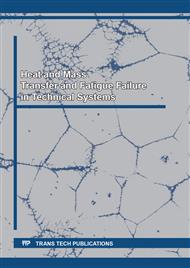p.21
p.39
p.53
p.73
p.81
p.103
p.109
p.115
p.121
Evaluation of Cyclic Tensile Stress Effect in Boiler Tube Failure
Abstract:
Boiler is one of the critical parts and plays an important role in Steam Generation Power Plant. It transforms the chemical energy of fuel into heat or thermal energy. During plant operations, some problems occurred in the boiler and Superheater leakage is the heaviest problem that interfered the whole operations, and the units needed to stopped for maintenaces outages. Failure analysis is necessary to determine the cause of failure. Root Caused Failure Analysis methods was through mechanical tests in the laboratory, which is Visual Observation included Macrofractography Structure examination, Metallographic or Microstructure Examination, Hardness Test. The metallographic examination result shows that the microstructure of the base metal is ferrite pearlite, and there is no indication of microstructure changes in tube as effect from high operation temperature. Likewise, microstructure in the weld region is in normal conditions, no weld failure phenomenon. Hardness value for base metal, weld and HAZ area are still in a good condition. Macrofractrography structure examination shows that the fracture is in mechanical fatigue condition. Based on those results the source of the tube leak is not caused by operating errors, inside or outside deposit nor weld failure. Superheater tube failures caused by mechanical factors, namely due to cyclic tensile stress as result in vibration by gas flow coupled with an increase in the local area due to the welding heat, therefore, increases the rate of crack propagation. To verified the data from mechanical test, CFD simulation will be used. CFD can detect the direction of the gas flow around the Superheater tube. The simulation result shows the possibility of turbulence flow around the tube, which creates the vibrations on the tube due to gas flow velocity. Thus, the superheater tube leakage mostly because vibration that create cyclic tensile stress.
Info:
Periodical:
Pages:
115-120
Citation:
Online since:
April 2022
Authors:
Keywords:
Price:
Сopyright:
© 2022 Trans Tech Publications Ltd. All Rights Reserved
Share:
Citation:


